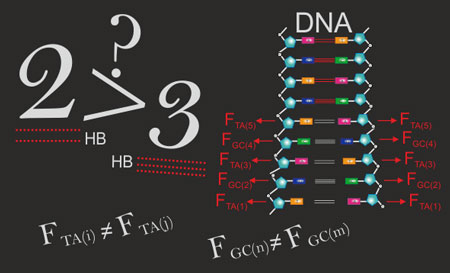Michael Berger’s Oct. 10, 2017 Nanowerk Spotlight article features research from the Institut Català de Nanociència i Nanotecnologia, (Catalan Institute of Nanoscience and Nanotechnology and acronym ICN2) which has nothing to do with recent vote on independence (for more, see this Oct. 23, 2017 article about how countries such as ‘Catalonia’ and others do and don’t gain independence in The Atlantic),
…
This is the first report on the electrical characterization of DNA with intrabond resolution.
Specifically, it quantifies electrical forces due to a single hydrogen bond in DNA and provides proof of a non-direct relationship between the number of hydrogen bonds in DNA pairs and the relative strengths of such pairs.
Such understanding of the relative strengths of the forces involved in the specific bonding of DNA as well as its electrical origin provides physical foundations to control mechanisms associated with DNA stability. It could help to develop new methods for the understanding, characterization; and control of relevant events originated at intrabond scales e.g. controlled DNA repair and damage; controlled modification of the expression of the genome; and communications below the single bond limit.
A blackboard representation of the manuscript’s key message: the quantification of the relative strengths between base pairs in DNA due to zipping hydrogen bonds might place on doubt such mechanisms regarding the interpretation of thermodynamic properties of DNA based on the assumption that A/T pairs are weaker than G/C pairs due to the sole difference in the number of hydrogen bonds, 2 and 3 respectively. (Image: Dr. Yamila García-Martínez)
Generally, being able to control DNA stability at the single bond level by means of electromagnetic interactions opens new avenues to induce modifications of the replication and transcription processes of DNA by means of noncontact methods.
….
Going forward, the researchers will study the effects of external electromagnetic fields on DNA at the level of single bond events. This will have not only an enormous interest in the medical field but also in nanotechnology where it would open the door to non-contact atomic manipulation of DNA – the analogue to the CRISPR gene editing method [emphasis mine] but using electromagnetic fields to drive changes in DNA.
Interesting stuff, eh?
Here’s a link to and a citation for the paper,
Unveiled electric profiles within hydrogen bonds suggest DNA base pairs with similar bond strengths by Y. B. Ruiz-Blanco, Y. Almeida, C. M. Sotomayor-Torres, Y. García. PLOS [Public Library of Science] https://doi.org/10.1371/journal.pone.0185638 Published: October 5, 2017
This paper is open access.
